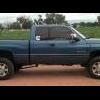For Sale - 2006 Dodge Ram 2500- Flatbed for long box bed Winch bumper Flat Bed for Long Box 3rd generation Cummins Tootlbox are included with key I have a flatbed for 3rd Generation dodge Cummins. This flatbed comes with a gooseneck hitch already in the bed. The winch bumper is part of the set. Tootlbox have a key to lock and unlock all box a single key. There is rust starting and electrical will have to be sorted out on your own.
-
Price: $1,000.00
-
Location: New Meadows, Idaho
 Mopar1973Man 18 posts
Mopar1973Man 18 posts TFaoro 10 posts
TFaoro 10 posts

So I'm picking up my truck, with its new VP44 on Tuesday and will be making a 12 hour drive with in on the following Sunday.
As I was looking my truck over before sending it off, I noticed way too much residue in the mouth of my Turbo. Considering that I run a K&N, I was pretty surprised. Then I started reading around here and my Turbo looks pretty much like the one in Mopar73's article about BHAF.
What I'm wondering is if I can use the tubin setup and heat shield from my K&N and get a BHAF to fit into the space?
If anyone has done this or knows about the size dimentions, I'd really appreciate it.
Normally, I'd just go get a filter and give it a go but, just coming out of a layoff and the expense of the new VP44, I just don't have a play around budget.
Any and all help is highly appreciated.
Thanks,
Doc
Edited by recondoc